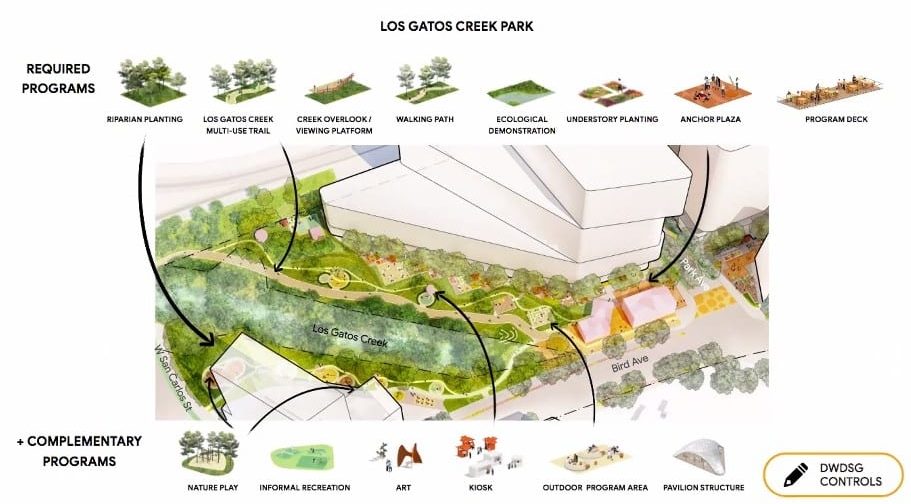As the city of San Jose and Google move toward transforming the city’s downtown, residents are casting wary eyes on their plans to reduce car traffic and address homelessness in the area.
Downtown Councilmember Raul Peralez, whose district encompasses downtown, hosted a community meeting for San Jose’s Diridon Station Area Plan (DSAP) and Google’s Downtown West project on Wednesday. It marked the beginning of the city’s public outreach for the plan in 2021, as well as the end of an uneasy year for Google.
“As someone that’s lived my entire life in the city of San Jose, I can definitely say I’m excited,” Peralez said. “But I’m nervous as well.”
The most recent development for both these plans was in December, when Santa Clara County’s Airport Land Use Commission rejected both the DSAP and Google’s project, saying the proposed height of the buildings pose a safety hazard.
DSAP project manager Jose Ruano covered the details of the proposed DSAP, such as increased height limits and a 25% affordable housing goal, after which Google’s social infrastructure director Ricardo Benavidez and Laura Crescimano of SITELAB Urban Studio described features of the 80-acre campus, including the 4,000 to 5,900 housing units the company plans to build.
A Q&A period followed the presentation, during which many residents expressed concerns about traffic, homelessness and displacement.


A resident named Mike, who lives downtown, questioned Google and the city’s push for fewer cars downtown. He noted that even if downtown residents use transit most of the time, they may need a place to park their cars in case they want to travel outside of the city.
Benavidez said roughly half of Google’s employees drive solo to work right now, a proportion which the company hopes to reduce.
“With the proximity of Diridon Station, we believe we can do better,” Benavidez said. “We definitely want to be aggressive … in terms of how our employees access the site.”
Eric Eidlin, station planning manager for San Jose, said the city is not trying to ban cars from downtown.
“With the increased amount of activity, it won’t be possible for everybody to drive in the same numbers they do today,” Eidlin said.
Another resident asked whether the city took into consideration the higher number of people traveling in cars during the pandemic. Eidlin said he and other city planners believe the increased use of cars is a short-term trend.
“We’re aware of the current trends, and the plan isn’t to exclude cars from anything, but to manage demand for parking in a smarter way,” Eidlin said. “We just don’t have infinite space.”
Deborah Hudson asked what the city and Google plan to do about homeless residents, who may be drawn to the parks and other swaths of green open space featured in the DSAP. Rachel Vanderveen, San Jose’s deputy housing director, said the city would use its existing programs to address homelessness in the area.


The company’s downtown plan also includes space for up to 300 hotel rooms, as well as 800 limited-term corporate lodging units. Rico said the land could be better used for housing since there are hotels located nearby. Benavidez said the demand for hotels was high before the pandemic, and that they expect the demand will rise again by the time the project is completed.
Residents Marni Kamzan and Branden Frederick asked whether Google’s plans have changed amid the pandemic, given the growing number of people working from home. Benavidez said the need and desire for people to work together in person remained, though the company is making adjustments based on new information.
Benavidez said Google expects to break ground in either late 2022 or in 2023, with its first phase of building on Santa Clara Street to last three to five years.
Most residents who spoke at the meeting appeared skeptical the plans would leave enough room for the city’s current inhabitants.
Jennifer Soboleski said she’s worried the 20,000 new jobs hosted at Google’s Downtown West campus will be filled by already highly-paid tech workers, who may not currently live in San Jose.
“I want to know that throughout this process … the highest priority is upon the people who live here now and that there is (a) heavy focus to ensure the project benefits all current residents in some way,” Soboleski said.
Benavidez said Google will present its plan to neighborhood associations across San Jose and that organizations may contact the company at [email protected] to schedule a meeting.
The city will post a video recording of the meeting on Peralez’s Facebook page.
Contact Sonya Herrera at [email protected] or follow @SMHsoftware on Twitter.



Leave a Reply
You must be logged in to post a comment.